Bulbs
Flower Basics
Flower Beds & Specialty Gardens
Flower Garden
Garden Furniture
Garden Gnomes
Garden Seeds
Garden Sheds
Garden Statues
Garden Tools & Supplies
Gardening Basics
Green & Organic
Groundcovers & Vines
Growing Annuals
Growing Basil
Growing Beans
Growing Berries
Growing Blueberries
Growing Cactus
Growing Corn
Growing Cotton
Growing Edibles
Growing Flowers
Growing Garlic
Growing Grapes
Growing Grass
Growing Herbs
Growing Jasmine
Growing Mint
Growing Mushrooms
Orchids
Growing Peanuts
Growing Perennials
Growing Plants
Growing Rosemary
Growing Roses
Growing Strawberries
Growing Sunflowers
Growing Thyme
Growing Tomatoes
Growing Tulips
Growing Vegetables
Herb Basics
Herb Garden
Indoor Growing
Landscaping Basics
Landscaping Patios
Landscaping Plants
Landscaping Shrubs
Landscaping Trees
Landscaping Walks & Pathways
Lawn Basics
Lawn Maintenance
Lawn Mowers
Lawn Ornaments
Lawn Planting
Lawn Tools
Outdoor Growing
Overall Landscape Planning
Pests, Weeds & Problems
Plant Basics
Rock Garden
Rose Garden
Shrubs
Soil
Specialty Gardens
Trees
Vegetable Garden
Yard Maintenance
How to Grow Carnations in a Container
How to Grow Carnations in a Container. Carnations are herbaceous perennials valued for their ease of cultivation and large, showy flowers. The plant's blossoms are widely used in cut flower arrangements and bouquets due to their range of colors, fragrant aroma and size. Each carnation flower reaches up to 3 inches in diameter. Gardeners typically...

Carnations are herbaceous perennials valued for their ease of cultivation and large, showy flowers. The plant's blossoms are widely used in cut flower arrangements and bouquets due to their range of colors, fragrant aroma and size. Each carnation flower reaches up to 3 inches in diameter. Gardeners typically grow carnations in the ground, though they may adapt to containers with the proper care. Native to Europe and Asia, carnations need cool temperatures to develop and thrive, but require only minimal care and maintenance.
Things You'll Need
Container
Potting soil
Thermometer
Fertilizer
Fill a medium-size container with a well-drained, fertile potting soil. Sow a carnation seed ? inch deep in the soil and water lightly. Place the container in a location that receives four to five hours of full sunlight each day. Keep the soil slightly moist and germination will occur in about six weeks.
Maintain a constant temperature of 60 to 65 degrees Fahrenheit at all times for the best flower and foliage development. Keep a thermometer near the plant to ensure the temperature does not rise above 65 degrees Fahrenheit, or permanent damage may occur.
Water container-grown carnations once per week to keep the soil consistently moist. Do not over-water or the foliage will yellow and possibly drop. Apply water directly to the soil to avoid moistening the leaves, as wet foliage is more vulnerable to pests and disease.
Feed carnations once every six to eight weeks using a 20-10-20 NPK fertilizer to provide necessary nutrition. Read the instructions on the package for proper dosage information. Water lightly after fertilizing to prevent root burn and distribute the nutrients throughout the soil.
Harvest blossoms after flowering has begun. Prune the carnation plant to about 1 inch above the soil level after flowering ends to rejuvenate the plant and prepare it for the next blooming season.
Repot carnations during early spring after two to three years of growth, or whenever the plants have outgrown their current growing container. Increase the size of the container by 3 to 5 inches and provide a fresh growing medium to ease the shock of transplant.
Tips & Warnings
Take divisions during repotting if desired.
Harvest carnation flowers during mid-afternoon, when sugar content is highest, for the longest-lasting cut flowers.
Continue providing four to five hours of direct sun throughout the plant's life. Carnations cannot tolerate low-light conditions.